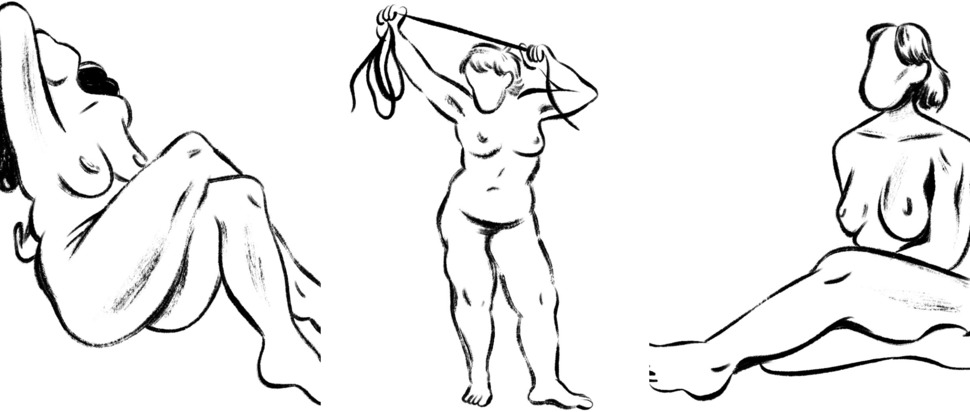Holding Still: On life modelling & bodily perceptions
A number of poses, a number of sketches – life modelling is a practice unto itself. One writer explores learning to see oneself and be seen in the artist's studio and beyond
It is a peculiar tonic, sitting still for half an hour. My ears itched, my thoughts wandered and my palms grew sweaty on my legs as I sat naked in a room full of easels and artists a few Wednesdays ago in Glasgow.
I life modelled for the first time last year; it’s something I’ve always wanted to do. My friend had an opening in her drawing class and I immediately volunteered. I saw it as a way to make amends to a body I have not always liked or been kind to; a therapist once asked me to list all the things about myself I liked and I cried for half an hour.
I’ve gone to my fair share of life drawing classes, stood on the other side of the easel and thought it only fair to try things in reverse; I wanted to see what it would feel like to be captured in charcoal and ink. The raw intimacy of eight strangers (and one friend) watching and recording my body from different angles was oddly calming. I’d anticipated nerves and self-consciousness but the stillness and sharp smells of turpentine were meditative. Indeed, the class was shyer than I was. With each pose, they whipped away their drawings so quickly I only caught glimpses of my arms and legs.
While I sat still, my mind slipped away to entertain fantasies; arguments and brief moments from my day. I watched the others paint – the flickers of concentration, the creases of their faces and how tightly they held onto their brushes. I watched a woman mix skin tones two shades too light for my complexion. Once, a man let his easel slip; I saw he’d given me larger boobs.
Life modelling forced me to reckon with my own body in ways I did not expect. I’d initially anticipated embarrassment as we rattled through thirteen poses in three hours. However, the quick-fire poses brought a new layer of physical discomfort as I spent each pose panicking about my next, realising the limitations of the flexibility I had overextended, the pliancy from my childhood that had vanished through neglect.
Sitting in the middle of the room during one of the longer poses, the glare of a spotlight bright in my eyes, I thought about how I have wasted a good portion of my life hating my appearance and continue to do so. Strangers saw parts of my body my parents haven’t seen for years. They saw the bruises on my knees, my belly rolls and the remnants of self-harm from my teens. Whilst life modelling, I thought about clothes and their protection; the parts of my body I hide in jumpers and colour. I kept on my jewellery because it felt like the last part of my identity I could keep on, besides my tattoos. As a teenager, when my parents found my first tattoo they were apoplectic; however, where they saw disfiguration I finally saw something I liked on my skin. Being able to bring them into the studio as an additive felt nice.
Since my breakup in April, I’ve spent the last few months in a cycle furiously downloading and deleting the dating apps in moments of weakness and disgust. With each shame-filled recreation of my dating profile, I find myself scrolling through the last ten years of photos. I look back at pictures of myself I hated at eighteen and see nothing wrong with them. Then, I wonder if I’m catfishing as I upload pictures from two years ago. I realise I don’t know what I look like. With every new profile, I wonder what image I want to project, who am I trying to impress? I flicker between different selections of photos; pictures in nature, pictures at home, pictures with friends. I realise I use busy photos to try and remove scrutiny from myself. Life modelling resists such self-curation.
Online dating is like standing at the fridge with the itch of hunger, opening and shutting the door hoping that something other than a half-eaten jar of mayonnaise might materialise. It is a shallow game entertaining ideas of people based on a few photos, a few caustic prompts; dismissing them on arbitrary whims. It feels vulnerable offering up your own image to similar layers of inspection, forcing you to look at yourself from an outsider’s perspective. I surprisingly found life modelling less scary; once my clothes were off it felt as if I had reached the limit of my own insecurity – there was nowhere left to hide.
My friend from the drawing class has known me since we were teenagers and I saw how that coloured her art. She was perhaps kinder with her brush strokes than the others because she knew me. Likeness is a hard thing to freeze onto paper. Strangers perhaps are gifted in that they can look without filters acquired through association. Small glimpses of the others’ artwork caught different aspects: my posture, the strands of hair I keep defensively over my face, my rings. The gaze of the artists in the class was not as piercing or invasive as I’d thought it would be. Life modelling reiterated for me the ways different angles draw different truths from the same interaction. I’d like to do it again, some time.
